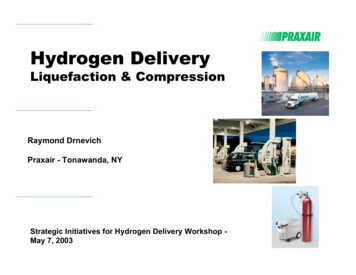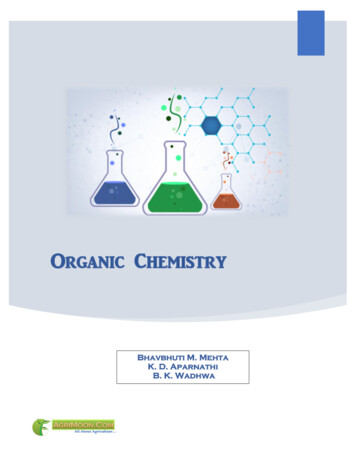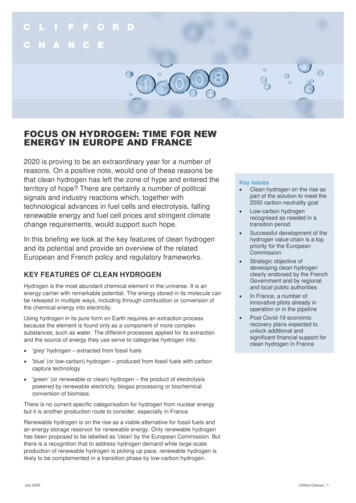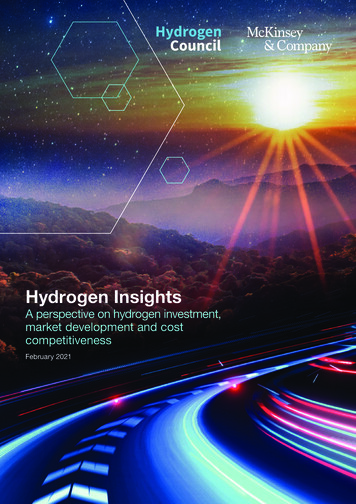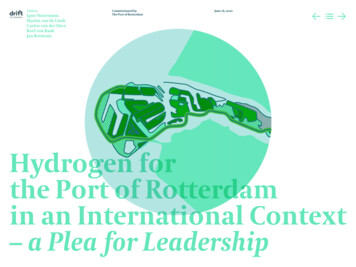
Transcription
AuthorsIgno NotermansMartin van de LindtCarien van der HaveRoel van RaakJan RotmansCommissioned byThe Port of RotterdamJune 18, 2020 Hydrogen forthe Port of Rotterdamin an International Context– a Plea for Leadership
Hydrogen for the Port of Rotterdamin an International Context– a Plea for LeadershipJune 18, 2020 Key MessagesLow-carbon hydrogen, such as green and blue hydrogen,offers a unique and rare opportunity for the Port ofRotterdam to remain a globally important energyand chemistry hub in the future. However, the Port’sindustrial cluster does not currently seem to be convincedof the urgency of taking a prominent position in hydrogendevelopments. The cluster and the Port of RotterdamAuthority must show leadership if we are to successfullycope with the risks, uncertainties, and large investmentsthat the hydrogen developments require.Hydrogen imports are needed – Next to electrification,green hydrogen will become an important part of ourfuture carbon-free energy system as an energy carrier andas a raw material for chemical production and zero-emission fuel. Still, locally produced green hydrogen does notoffer any emission reduction in the short term, requireslarge investments and local production will not be enough.The Port of Rotterdam, the Netherlands, and Northwestern Europe will remain dependent on energy imports.Global trade flows and associated geopolitical interestswill continue to exist – In a global energy system inwhich hydrogen plays an important role, trade flows willemerge between regions with a surplus of renewableenergy and those with a shortage, such as NorthwestEurope with its energy-intensive industrial clusters.Trade routes will not be determined only by businesscases but by geopolitical interests as well.Energy imports remain necessary – It is a myth thata sustainable energy system in the Netherlands couldbecome energy independent. Northwestern Europe hasa joint task to decarbonize and simultaneously produceand import renewable energy.Rotterdam has a unique and exceptional position forhydrogen – Rotterdam is currently a fossil superpower;low-carbon hydrogen offers the opportunity to maintainthis dominant position as an energy and chemical cluster. In addition to a hydrogen production and user hub,Rotterdam’s main potential is as an import and tradehub for low-carbon hydrogen due to its current strongposition on a global level. The plans for blue hydrogenoffer a unique bridging opportunity to reduce emissionsin the short term.However, it is far from certain that Rotterdam willacquire a dominant position in hydrogen – Rotterdam’scurrent strong energy hub position does not mean thatit is the only or most logical place for hydrogen developments. Hydrogen trading can bypass the Port bytransporting it via pipelines, and large-scale productionnear the wind farms in the North Sea does not have topass through the Port. Other clusters are involved in the“battle for hydrogen” as well, so it is far from certainthat Rotterdam will become the hydrogen hub of Northwest Europe.Leadership is necessary to cope with the risks, uncertainties, and large investments that hydrogen developments require. Low-carbon hydrogen should be seen asone of the few vital lifelines for the future of Rotterdam,where one runs the risk of being late if action is nottaken proactively and cooperatively now. The Port ofRotterdam should take risky “regret” actions to developthe various hydrogen hub functions, even though Rotterdam will not become great in all of them. History showsthat such leadership is within the DNA of the Port.Leadership strategiesTo create a breakthrough in hydrogen developments, weidentify five main leadership strategies for the the Portcluster and the Port of Rotterdam Authority:1 Simultaneously build up all four possible hydrogen hubfunctions for the Port now—user, production, import,and trading hub—to develop a position in hydrogenon a global level. For now, the focus should be on animport and production hub as these fit the currentcluster well. This strategy implies investing in possible “regret” options that turn out to be unattractive orunprofitable over time when hydrogen developmentstake shape.2 Financing low-carbon hydrogen should neither bebased on CO2-savings nor on technological innovations, but on the long-term value of investing now inupscaling technology and preparing infrastructure.3 Proactively develop the trade and production of hydrogen elsewhere in the world, thereby making use of theknowledge and expertise Rotterdam already possesses.For example, Rotterdam has knowledge in the field ofdigitalization and sustainability of ports; in exchangefor this knowledge, Rotterdam can gain access togreen hydrogen in the regions and countries that willproduce it. Global trade routes around hydrogen areemerging, and international cooperation with other regions is vital. This is urgent—the cards are nowshuffled, and the hydrogen hub functions will soon bedistributed.4 Create “outside-the-box” demand for green hydrogen in niche markets where there is willingness topay a premium. The next ten years will be crucial indeveloping the market for green hydrogen. Without anexisting profitable revenue model, this is possible onlythrough start-up subsidies from the government andpre-investments by companies. The Port could start bydeveloping an ecosystem of hydrogen initiatives withinthe cluster, for example by involving the logisticschain, but also by building public infrastructure (forwhich the first steps are being taken).5 Establish an iconic first import shipping route withgreen hydrogen in the short term to put Rotterdam onthe map as an import and trade hub for hydrogen. Thegreen spider project responds to this call by developinga green hydrogen chain from Portugal via the Port toRotterdam’s hinterland.
June 18, 2020Hydrogen for the Port of Rotterdamin an International Context– a Plea for Leadership Table of ContentsPrologue04Chapter 1Introduction: Toward breakthroughs for low-carbon hydrogen05Chapter 2The emerging global green hydrogen economy09Chapter 3Emerging green hydrogen in Northwest Europe13Chapter 4Urgency for the Rotterdam Port cluster21Chapter 5Rotterdam’s window of opportunity to become a first mover25Chapter 6Reorient subsidy instruments into a transition27proposition from society, government, and industryChapter 7Face the need for energy imports, and activelyColophonAuthorsIgno NotermansMartin van de LindtCarien van der HaveRoel van RaakJan Rotmans30Art Direction & DesignKate Snow Designdevelop hydrogen trade relationsChapter 8Create demand outside the box35Chapter 9Rotterdam as first mover in establishing hydrogen trade routes37Epilogue39Endnotes45 DRIFT 2020Notermans, I., Lindt, M. van de, Have,A.C. van der, Raak, R. van, Rotmans, J.,Hydrogen for the Port of Rotterdam inan International Context- A Plea forLeadership, DRIFT, Erasmus UniversityRotterdam, Rotterdam, 2020.
04PrologueHydrogen for the Port of Rotterdamin an International Context– a Plea for LeadershipJune 18, 2020Prologue Photo by Mike van den Bosch onUnsplash / Colors modifiedThe transition-agenda Hydrogen for the Port ofRotterdam in an International Context – A Plea forLeadership was largely developed before theCOVID-19 crisis appeared and its ripple effectsbecame an economic crisis and a highlyvolatile, oversupplied energy market resulted.However, this does not imply that this agenda hasalready become obsolete. If anything, current developments bring forward the future of our energy system.On the short term, an oversupply of fossil fuels on theworld market will severely impact business cases forrenewable energy and thus for green hydrogen. Also,investments in green energy will be lower in 2020 thanin previous years (IEA Outlook). In the middle and longterm, however, the current oversupply of fossil fuelsmight bring forward a hard correction in investmentlevels in fossil energy. Over the last decade, investments in green energy have grown exponentially whileinvestments in fossil energy continued, including majorsunk investments in large-scale infrastructures that willtypically last decades before being written off the books.In these circumstances, even under continuous economicprosperity, a clash of investments was bound to happen.The current crisis will likely result in an unparalleleddecline in fossil energy investments or even the reversalof investment decisions and hastening of the decommissioning of older, less competitive fossil plants andinfrastructure, which will last longer than the directpandemic crisis. In the middle and long term, this willcreate space in the energy markets for sustainable alternatives, which would have taken much longer to developwithout a crisis.In addition, an early advantage for green hydrogenproduction might be that, for both fossil and renewableelectricity, prices have dropped dramatically, lowering,at least in absolute terms, the costs of green hydrogenproduction.Therefore, the challenge is to bridge the short-term lackof investment and negative business cases for the longerterm. This will undoubtedly require a deepening of shortterm investments while markets will be hesitant to investgiven the current levels of volatility, uncertainty, complexity, and ambiguity. The crisis, however, also unlockeda new belief in public investment to stimulate economicrecovery and in the role of public parties to secure necessities, such as energy, in a volatile world. Although at thetime of publication, fierce debates about the mechanismsat the European level in funding the economic recoveryare ongoing, a movement toward scaling up economicrecovery is clear. This is in line with the argument in thisagenda to move beyond national energy system agendasto at least the level of connected European regions.Hydrogen plays an important role in the currently proposed green deal as part of the EU recovery strategy.In the vast solar resources of hard-hit countries in thesouth, hydrogen could improve the trade balance of thesouth with continental Northwestern Europe’s energy sink.Governments can make hydrogen part of the economicrecovery through direct investments but also by ensuring that investments in other aspects of the economicrecovery are conditional upon simultaneously greening our economy. Governments can also revise existingsustainability regulations, such as the Renewable EnergyDirective, to allow the use of green hydrogen (certificates)to count toward compliance with such regulations.It will require the leadership sought by this agenda tokick-start the role of green hydrogen in a sustainableenergy system to both strengthen economic recovery andkeep climate targets in reach. We hope this agenda contributes to a shared sense of urgency for such leadership.
05Chapter 1 IntroductionToward breakthroughsfor low-carbon hydrogenHydrogen for the Port of Rotterdamin an International Context– a Plea for LeadershipJune 18, 2020 Chapter 1Introduction – Towardbreakthroughs forlow-carbon hydrogenHydrogen is gaining increased attentionfrom policymakers and industry leaders asa necessary element for a fully renewableenergy system. It is also seen as an economicopportunity for greening existing industriesand as a basis for entirely new ones, suchas biobased industries. In the Dutch portof Rotterdam, this growing attention forhydrogen has led to activated and interestedbusiness and industries, policy collaborations,and other initiatives, but overall, a coherentperspective and a sense of urgency is lacking.This document is the first step to that end and is theresult of a “transition arena” consisting of dialog sessionswith people from both industry and science with differentperspectives (see also Textbox 2). The focus is on “green”hydrogen developments in connection to “blue,” but as(many) other colors of low- to zero- carbon hydrogenexist and have comparable developments (see Textbox 1),we usually refer to “low-carbon” hydrogen. Parallel toand in connection with this process, the Port of Rotterdam has also released its vision on hydrogen, whichresembles many of the ideas presented here1.Examples of other hydrogen-related activities withinthe Rotterdam cluster are the project H-vision for bluehydrogen (feasibility study)2, green hydrogen production plants announced by BP-Nouryon3 and Shell-Eneco4 (feasibility study and tender proposal), and theconstruction of an openly accessible hydrogen pipelinein the cluster by the Port of Rotterdam and Gasunie5. In the north of the Netherlands, Shell, Gasunie,and Groningen Seaports have stated the ambition ofrealizing “Europe’s largest green hydrogen project” bycompleting a wind park with a capacity of 3 (2030) toa of maximum 10 (2040) gigawatt in the North Sea toproduce 0.8 Mt of green hydrogen6.On the policy side, the Dutch government announcedsignificant innovation funding and, recently, theirhydrogen vision, in which carbon-free hydrogen is animportant element in a sustainable energy system7. Italso highlights the strategic importance of Rotterdamas an international energy hub and the opportunitiesthat hydrogen provides the Rotterdam cluster. Theseinitiatives have arisen at the Dutch national level, butthere have been similar developments by other regional (Zuid-Holland8), national (Germany9), European(Hydrogen Europe10) and international (InternationalEnergy Agency11) organizations. Despite these policiesand innovation funding, financing hydrogen initiativesis easier said than done.The Port of Rotterdam urgently needs to define itsposition in the hydrogen chain, as it risks losing itsimportant mainport position for Northwest Europe.Much effort is needed to bring low-carbon and especially green hydrogen to scale in the coming years,where all parties need to work together to benefit fromthe potential hydrogen offers. Low-carbon hydrogen isone of the few chances for Rotterdam to gain a competitive edge in transforming its fossil commodity chemical industry (and build up a new green industry) andto preserve and strengthen Rotterdam’s position as animport hub for Northwest Europe. A “wait-and-see”attitude is thus not an option.The above-mentioned initiatives do show that in a relatively short timeframe, low-carbon hydrogen movedfrom a marginal niche strategy to a serious ambition ofboth governments and businesses. Several (pre-)feasibility studies and (pre-)coalition developments havebeen published. However, for the Port of Rotterdam tobecome a serious frontrunner in low-carbon hydrogen, these ambitions must be translated into concreteaction. More investments beyond the current feasibilitystudies are required, and collaboration between a groupof the willing and able is needed to develop this marketfor green hydrogen. In addition, green hydrogen is oneof the very few chances for an alternative to the fossilenergy import hub in Rotterdam.Of course, developments in the Rotterdam clusterdepend on developments in the international policy stage (e.g., carbon pricing). However, this shouldnot lead to a waiting game in the Rotterdam cluster.The favorable conditions for the Port of Rotterdam tobecome a frontrunner in green hydrogen chains can(and must) be created largely in the scope of Northwestern Europe.
06Introduction: Towardbreakthroughs forlow-carbon hydrogenHydrogen for the Port of Rotterdamin an International Context– a Plea for LeadershipTo understand these favorable conditions, we explore thefuture hydrogen chain at three levels: global, NorthwestEurope, and the Rotterdam cluster of port and industry.To better understand the urgency for concrete action,the first half of this document will outline an integralanalysis: The emerging global trade in sustainable energy carriers (Chapter 2); the future energy landscape inNorthwest Europe, including the role of imports(Chapter 3); and the opportunities and challengesfor Rotterdam to maintain its strong current positionas energy (and related feedstock) hub in NorthwestEurope’s feedstock hub for transport and processing(Chapter 4). In the second half, we will address theleadership needed to maintain this position by strivingfor a frontrunner position in green hydrogen (Chapter 5),and we will translate this into an agenda for four challenges and breakthroughs for producing and importinggreen hydrogen in Rotterdam (Chapters 6–9). Figure 1Three levels ofanalysis: global,NorthwestEurope, and theRotterdam cluster of port andindustry area.June 18, 2020
07Introduction: Towardbreakthroughs forlow-carbon hydrogenHydrogen for the Port of Rotterdamin an International Context– a Plea for LeadershipTextbox 1Colors of HydrogenHydrogen is a colorless gas (or liquid), yetthe process by which hydrogen is producedis often designated with a color. Althoughthere can be small differences in impuritiesbetween gray, blue, and green, all hydrogenis essentially the same product regardlessof “color.” There are three main productionmethods:Green hydrogen – a very different production methodin which green hydrogen is produced from water usingelectricity from renewable sources in a process calledelectrolysis, such as alkaline electrolysis or ProtonExchange Membrane electrolysis. Some hydrogen isalready produced this way, for example, when producing small volumes/at remote locations, when coupledto hydropower plants, or as a byproduct of chlorineproduction.Gray hydrogen – produced from natural gas, with CO2 asa byproduct, typically through chemical processes suchas “Steam Methane Reforming” (SMR) or “AutothermalReforming” (ATR). Currently, most of the world’s hydrogen is produced as grey hydrogen, from natural gas.Many other colors are used to refer to other production methods, although less often and less consistently,such as orange (produced in the Netherlands from localrenewable energy sources), yellow (produced by solar,e.g., in the Sahara), brown (from biomass/biogas), golden (biomass with CSS, thus negative emissions), purple(nuclear), black (electrolysis from coal- and gas-firedpowerplants), turquoise (produced by leading naturalgas through a molten metal which releases hydrogenand solid carbon), and many more. These colors can beapplied to physical flows of hydrogen, but through certification (guarantees of origin), the trade can also be separate from the physical flows (as with green electricity).Blue hydrogen – similar production methods (bothSMR and ATR are used) to gray hydrogen, but CO2 is notreleased into the air but “captured” and stored (CCS) orused to make chemical products or grow plants (CarbonCapture Utilization [CCU]). When combined, CCS andCCU is often referred to as CCUS. June 18, 2020 Textbox 2MethodologyThis document is the result of a “transition arena,”a series of dialog sessions with people attending in apersonal capacity from industry and science and withhighly different perspectives. These sessions were fed bytheory about transitions, analysis, and interviews doneby DRIFT (Dutch Research Institute for Transitions, atErasmus University), which also synthesized these dialogs into this document. This document is thus a primeexample of the “co-production” of knowledge betweenscience and practice.The responsibility for this final document, includingany errors or omissions, rests, however, solely withDRIFT, and the views expressed in this document donot necessarily reflect the views of the participants orthe organizations for which they work. The project hasbeen funded by The Port of Rotterdam Authority (Port ofRotterdam in this document), who also participated inthe sessions, along with –Elmer de Boer EnecoSilvan de Boer EnecoRobert Bouma Commercial Manager Energy& New Business, Nouryon)Hans Coenen Director strategy & businessdevelopment, GasunieSteven Engels General manager Benelux,ØrstedLeo Freriks New Energy Business, SiemensEnergy Nederland B.V.Marcel van de Kar Director New Energies, VopakThijs ten Brinck Wattisduurzaam.nlJan-Coen van Elburg RebelNoé van Hulst on personal titleJohn Kerkhoven Partner, KalavastaCoby van der Linde Director, Clingendael International Energy Programme[CIEP], professor Energy andgeopolitics RUG
08Introduction: Towardbreakthroughs forlow-carbon hydrogenHydrogen for the Port of Rotterdamin an International Context– a Plea for LeadershipJune 18, 2020 Textbox 2MethodologyJulius Smith Head of Business Development, ØrstedProf. Dr. Henk Volberda Professor of Strategy &Innovation, UvADirector of the AmsterdamCenter for Business InnovationProf. Dr. Ad van Wijk Professor of Future EnergySystems, TU Delft, GuestProfessor Energy and Water –KWR Water Research InstituteIn addition, international experts have been involved tovalidate and enrich the international perspective on Rotterdam through interviews and reviews. Some of theircontributions are included in this document as writtenreflections (see page 12, 19 and 33.). These internationalexperts include – Deputy Director at the GlobalClimate Bureau Ministry of theEnvironment in Japan & PhDCandidate, Nagoya UniversityRoy Green Chair, Port of Newcastle, andEmeritus Professor, Universityof Technology SydneyPaul Hodgson General Manager, Innovationand Stakeholder Engagement(East Coast), National EnergyResources AustraliaStefan Lechtenböhmer Director of Future Energy andIndustry Systems, WuppertalInstitute & Adjunct Professor,Lund UniversityLastly, the Wuppertal Institute provided additionalknowledge about the emerging hydrogen economy andindustry, especially in the German and internationalcontext, and has also reviewed the work of DRIFT. Thisagenda for low-carbon hydrogen aims to complementthe Port of Rotterdam’s H-vision for local blue hydrogenproduction, although some leadership challenges areshared between blue and green hydrogen.On behalf of DRIFT the arena process has been facilitatedand supported by:Carien van der HaveMartin van de LindtIgno NotermansRoel van RaakProf. dr. ir. Jan RotmansMuneki Adachi Port of Rotterdam by Bert Knot is licensed under CCBY 2.0 / Colors modified from original
09Chapter 2The emerging global greenhydrogen economyHydrogen for the Port of Rotterdamin an International Context– a Plea for LeadershipJune 18, 2020 Chapter 2The emergingglobal greenhydrogen economyCurrent pressures on our global energy system,such as impending climate change, resourcescarcity, and price volatility for fuels andenergy carriers, steer us in the direction of adecarbonized future economy in which lowcarbon hydrogen plays a significant role.Hydrogen is the most abundant element onEarth. It can be used as feedstock for importantchemical industries, as an energy carrier, and asan emission-free fuel. When produced throughwater electrolysis powered by renewableenergy, it is seen as key in enabling the energytransition and realizing a new, green economy.It offers a decarbonized alternative to naturalgas and can be used in aviation, mobility,logistics, building heat and power, industry,electricity generation, and storage.In a hydrogen world, the global energytrade will still exist In this future economy, low-carbon hydrogen tradenetworks will be present on a global level, comparableto the way fossil fuels are traded globally today. Therewill be regions with a surplus of cheap renewable energy because of available space combined with positivewind and solar conditions, such as, potentially, Australia, Northern Africa, Latin America, and the MiddleEast (see Figure 2 and Figure 3). Other regions, suchas Japan, will trade with regions willing to pay for thisenergy, hydrogen production, and its transport becauseof regional energy scarcity, due to less favorable climatic conditions, density of population, and energyintensity of industry. Of course, the level of trade isalso dependent on the need and (in)ability of the sourceregion to distribute their (renewable) energy and fordomestic use through national grids.Blue hydrogen will also be part of this trade system,especially when the market for low-carbon hydrogen isnot yet fully developed. With rising prices of CO2 emissions, the price of blue hydrogen will be comparable tothe prices of gray hydrogen, which eases the marketentry12. In this case, locations with the possibility ofusing, for example, greenhouses, chemical productionprocesses, and plastics or capturing CO2 emissions fromthe production of hydrogen (CCS), supply hydrogen (orcertificates to guarantee the origin of hydrogen). as will the geopolitics of energyAs with fossil fuels, the trade routes will be determinednot only by natural, technical, and cost factors, but alsoby geopolitical factors. History shows that industrialtransitions on a global scale can lead to a shift in powerbetween regions and in the geographic focal points ofhubs. Hydrogen supply will originate in countries withextensive renewable energy capacity that offer electricity for low prices. In addition, countries that have adominant (fossil) energy exporting position and havefavorable climatic conditions for renewable energyproduction (and the resources for such investments,e.g., Middle Eastern countries) may try to maintain thisposition through hydrogen export13. Many countrieswith excellent natural conditions and space availabilityoften deal with political instability, either domesticallyor in neighboring countries whose territory must becrossed for access to the rest of the world.Thus, the global transition to hydrogen might implygeopolitical risks because of new trade routes andsupply dependencies of geopolitically unstable regionsand countries (in North Africa, Middle East, and LatinAmerica). Although what might happen in the future isspeculative, our best guess is that the geopolitical risksregarding the hydrogen trade will at least be comparable with the geopolitical risks related to oil and coaltrading. The very idea of becoming energy autonomousfor the Netherlands or Northwestern Europe is illusory;the dependencies will be at least as large as the current dependencies on fossil fuels. In regions such asNorthwest Europe, which will become a large importerof hydrogen (see Chapter 3), will need to be alert tothe impact of geopolitics on their supply chains. Onesolution can be found in strengthening the resilienceof supply chains by importing via multiple routes andfrom various suppliers.
10Chapter 2The emerging global greenhydrogen economyHydrogen for the Port of Rotterdamin an International Context– a Plea for LeadershipJune 18, 2020 Figure 2Example visualization of the current difference in costsof producing green hydrogen locally in the Netherlandsor in other countries and transporting hydrogen.This is based on the HyChain II model. Please notethis is an exploratory model and highly dependenton assumptions. One simplification is that the model assumes production in the geographic center of acountry, so coastal production might be cheaper. For thevisualization, the default values in the reference modelwere used, with a maximum pipeline transport of 3,500km and a maximum inland transport to port of 500km. Please note this visualization does not representthe availability of energy (or whether it is to be usedlocally or exported elsewhere for economic efficiency).The model represents current costs and prices. For moreinformation and the model itself, see here.Cost differencesustainablehydrogen production Figure 3Cost difference between producingammonia locally in the Netherlandsor producing green hydrogen elsewhere and, before transporting it,converting it to ammonia.This is based on the same model asFigure 2, using the default parameters in the reference model.Cost differenceammonia production,local vs. elsewhere
11Chapter 2The emerging global greenhydrogen economyIntercontinental transport costs are surmountable but lead to diverse forms oftransportThe obvious argument against a global hydrogen trade isthe availability of low-carbon hydrogen and the cost oftransport.Although renewable energy has become the lowest-costsource of new power generation in most parts of theworld14, little (less than 0.1% of global dedicated hydrogen production today comes from water electrolysis)renewable energy is used to produce hydrogen. Renewable electricity production can still be absorbed for directuse into national grids almost everywhere in the world,which does not stimulate trade in green hydrogen.However, at some point, the availability of space and theright climatic conditions will become more of a decisivefactor than investment and transport costs. Areas suchas Japan and Northwest Europe will simply run out ofspace for renewable energy production to meet theirenergy demand. Additionally, when the prices of renewable energy drop even further and the market for hydrogen scales up, the cost of hydrogen production throughelectrolysis, in comparison with hydrogen productionfrom natural gas or coal, is no longer significant (e.g.,IEA expects a price drop of 30% for producing Hydrogenfrom renewable energy15).Still, the high transport costs – owing to the high costs ofchemical conversion, liquefaction, or compression, compared to, for example, LNG, and especially oil (products)– will impact the way transport is organized; from sourceto user, supply chains will be formed that minimize costs.This will result in a diversification of the forms of transport. Where possible, pipelines will be used for transport or energy will simply be imported as electricity fordirect use or near-user conversion into hydrogen up to3000 km. Over longer distances, such as intercontinentaltransport, shipping will become the dominant transportmode by using the currently promising liquid organichydrogen carriers (LOHCs), for example.The end use will also determine in which form hydrogenis transported. For example, currently, almost half ofglobal hydrogen usage is feedstock for ammonia produc-Hydrogen for the Port of Rotterdamin an International Context– a Plea for LeadershipJune 18, 2020tion (fertilizer)16. Conversion a
Rotterdam's window of opportunity to become a first mover . 25 Chapter 6. Reorient subsidy instruments into a transition . 27. proposition from society, government, and industry . Chapter 7. Face the need for energy imports, and actively . 30. develop hydrogen trade relations. Chapter 8.


